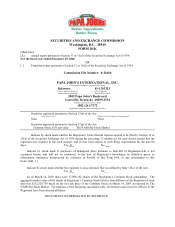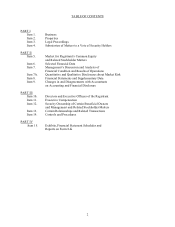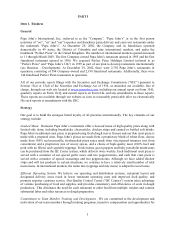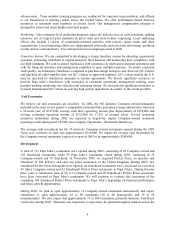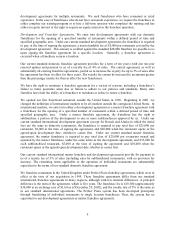Papa Johns 2002 Annual Report Download - page 8
Download and view the complete annual report
Please find page 8 of the 2002 Papa Johns annual report below. You can navigate through the pages in the report by either clicking on the pages listed below, or by using the keyword search tool below to find specific information within the annual report.7
the Co-op for market-wide programs, such as radio, television and print advertising. The rate of
contribution and uses of the monies collected are determined by a majority vote of the Co-op’s members.
The restaurant-level and Co-op marketing efforts are supported by print and electronic advertising
materials that are produced by the Papa John’s Marketing Fund, Inc., a non-profit corporation (the
“Marketing Fund”). The Marketing Fund produces and buys air time for Papa John’s national television
commercials, in addition to other brand-building activities, such as consumer research. All domestic
Company-owned and franchised Papa John’s restaurants are required to contribute a percentage of sales
to the Marketing Fund. The contribution percentage was 1.25% throughout 2002 and increased to 2.0%
for 2003.
Restaurant-level marketing programs target the delivery area of each restaurant, making extensive use of
targeted print materials in direct mail and store-to-door couponing. The local marketing efforts also
include a variety of community-oriented activities with schools, sports teams and other organizations. In
markets in which Papa John’s has a significant presence, local marketing efforts are supplemented with
radio and television advertising.
We provide both Company-owned and franchised restaurants with catalogs for the purchase of uniforms
and promotional items and pre-approved print marketing materials. We also provide direct marketing
services to Company-owned and franchised restaurants using customer information gathered by our
proprietary point-of-sale technology (see Company Operations – Point of Sale Technology).
We have developed a system by which all domestic Papa John’s restaurant customers are able to place
orders on-line via the internet. We receive a percentage fee based on on-line sales, from domestic
franchisees, in addition to royalties, for this service.
Company Operations
Restaurant Personnel. A typical Papa John’s restaurant employs a restaurant manager, one or two
assistant managers and approximately 20 to 25 hourly team members, most of whom work part-time. The
manager is responsible for the day-to-day operation of the restaurant and maintaining Company-
established operating standards. The operating standards and other resources are contained in a
comprehensive operations manual supplied to each restaurant. We seek to hire experienced restaurant
managers and staff, provide comprehensive training on operations and managerial skills, and motivate
and retain them by providing opportunities for advancement and performance-based financial incentives.
Historically, we employed area supervisors, each of whom had responsibility for overseeing three to six
Company-owned restaurants. We also employed district managers who oversaw area supervisors and
managers within their respective markets. Beginning in 2003, we combined the area supervisor and
district manager positions into a director of operations position (see Company Operations – Restaurant
Initiatives).
Restaurant Initiatives. During 2002, several restaurant initiatives were undertaken with the ultimate goal
of improving the quality and consistency of the customer experience. The first of these initiatives was the
development of a systematic approach to monitor and evaluate key components of the total customer
experience, the refinement and enhancement of which is ongoing. A second initiative was an across-the-
board increase in base pay for restaurant general managers and assistant managers in an effort to attract
and retain the desired quality of individuals to these critical positions. In January 2003, we realigned
field operations management by combining the area supervisor and district manager positions into a
director of operations position. A director of operations is responsible for seven restaurants on average,
thus providing higher-quality direct support to our general managers and their teams. The cost savings
from the field management realignment are being invested back into our restaurants in the form of
increased staffing and greater bonus opportunities for general managers and their assistants.

